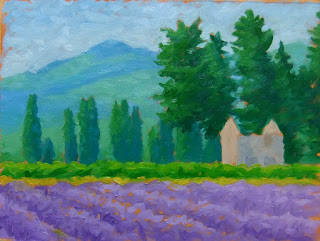I introduced colour into my drawing class last week. We worked with coloured pencils and soft pastel. In my opinion, it is easiest to start colour in monochromes. I asked everyone to bring a couple of tones of one colour plus white and black. Here are a couple of demos, one in coloured pencil and one in soft pastel.
 |  |
| coloured pencil | soft pastel |
Here is a short demo explaining each process. When starting with a new material, I like to begin with a simple tonal scale. It allows me to understand how to create gradations and transitions from one tone to the next.
Coloured Pencil:
For the coloured pencils, I worked with three tones of blue, a pale, medium and very dark tone as well as white. The drawing is done on smooth bristol. Here is the tonal scale.

Coloured pencil is best work up in many progressive layers, using a constant pressure of application. Since it is not an opaque medium, it is also better to work from progressively lighter to darker. In order to get a smooth gradation of tones, I will apply the lighter tone first, then the darker tone over top. When I want to get a subtle change in tones I will layer the coloured pencils very progressively, interweaving the tones. Here is the pear drawing in its stages:
 |  |
| The lightest blue is used to block in the large shapes. Attention is paid to the shape of light and shadow. | The light shade of blue is applied in several layers before starting to add the darker blue coloured pencil. |
 |  |
| The darker tone of blue of blue is used to strengthen the shadow on the pear, while the lighter tone is applied again in the background. | The darker tone of blue is applied to the background. The darker tone appears lighter because of the many layers of lighter tone beneath it. The lighter tone of blue is also added to the area between the light and shadow of the pear. |
 |  |
| I repeat the layering of light and dark tones on the pear and background until the paper seems almost saturated with the coloured pencil. | In the last stage I add the darkest blue into the shadow of the pear. I also add several layers of the lighter tone of blue to soften the transition between light and shadow. |
Soft Pastel:
Soft pastel is worked differently then coloured pencil because it is an opaque drawing medium. This means that I can apply dark over light or light over dark in order to achieve different gradations of tone. I am working with Prismacolor Nupastels using several tones of blue plus white. I am using Canson Mi Teintes paper in a creamy off-white. Here is the tonal scale:

 |  |
The drawing is blocked in with white.
| The lights and shadows and blocked in with white and the lightest blue. |
 |  |
| The light tone of blue is added to the background. The middle tone of blue is added to the shadow side of the pear. The drawing becomes sharper by working the different areas of light and dark. | Blending in the colour: This is an optional stage. By finger blending the tones the colour of the paper is covered up. I will generally do this only at the beginning of the drawing because over blending will make the colours dull and lifeless. |
 |  |
I add white and the light tone of blue to the background and foreground using loose cross hatched strokes. I put more white over the blue in the foreground to make certain it is lighter.
| I strengthen the shadow of the pear with the middle tone blue. I continue to cross hatch the light blue and white in the background and foreground. |
 | Here is the finished pear drawing. Although I was using only three tones of blue plus white, I am able to get many different subtle tones of blue by applying multiple layers of colour.
Soft pastel is a unique drawing medium because I can create drawings that are graphic and painterly at the same time. Because of its opacity, I can layer light of dark and dark over light to create different tones. |








































